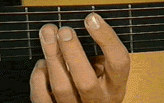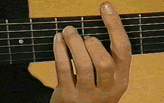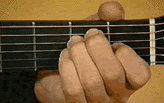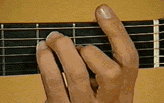|
C Major Barre Shape |
|
G Major Barre Shape |
 |
 |
|
|
E Major |
F Major Barre |
|
 |
 |
These two movable chord shapes can be substituted for the open
chords of the same name.
They are known as bar chords because the index finger, (sometimes accompanied by
others -see picture chords guide part 1 for an example of a single finger bar
chord - ) forms a bar across several strings at once and takes the place
of the string nut at the end of the fret-board.
learn one bar chord shape and hey presto - You already know 12 chords..
|
C Major Barre Shape |
|
G Major Barre Shape |
 |
 |
|
|
E Major |
F Major Barre |
|
 |
 |
The F Major bar chord illustrated above, does not appear in the
song Hey Joe. I have put it here, to demonstrates one of the purposes of the
string nut. -The white line seen on far right of the F bar chord and E
chord pictures - and also, because it is probably the most difficult standard
bar chord to play. If you can get that one you can get all of them.
If you study the E Major shape and compare it to the F bar chord shape, you will
see that the F chord is simply the E chord moved up one fret, with the index
finger then put across the strings to take the place of the string nut - The 1st
fret is hidden behind the index finger in the F chord picture.
Normally you would play the E chord using your - index - middle and ring fingers. But if you play it using your - middle - ring and little finger instead, you will find that when you slide the shape up one fret, the index finger is right there, ready to take the place of the nut and play the F Major chord. Move it up one more fret and you have the chord of F# Major (F sharp Major), one more again and you will be playing the chord of G major. (As seen in picture - above top right )
The C Major bar chord shape (see picture above top left) can be
moved along the frets in the same way. By flattening your fingers from the F
Major shape into the C Major shape and staying at the 1st fret, the chord
of Bb Major
(B flat Major) can be formed, - Don't be discouraged if this seems difficult at
first. Try and kept your wrist and hand as relaxed as possible and only apply
just enough pressure to sound the notes - Try the shapes further along the
fret-board, if the lower positions are causing you trouble, with a little
perseverance you'll soon get the hang of it.
Once again, by moving this shape along the fret -board other chords can be
created.
Move along one fret from the Bb
position for B Major, move along
one more for C Major and so on up the length of the fret board. Not bad that,
two shapes and now you know 24 chords...
For an explanation of sharps, flats and basic chord construction - See my
beginners guide to chord construction.
Hey Joe some of the possible substitutions
C open for C barre.... Play - C Major barre shape index finger at 3rd fret.
G open for G barre.... Play - G Major barre shape index finger at 3rd fret
D open for D barre.... Play - C major barre shape index finger at 5th fret
E open for E barre..... Play - C Major barre shape index finger at 7th fret
(Tip) On the E barre chord you can strike all the strings and leave the LOW E string to ring out in the open position, The combination of deep droning E string and higher pitched barred strings, makes for a very pleasant resonant sound.